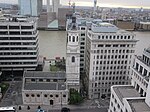2019 London Bridge stabbing

On 29 November 2019, five people were stabbed, two fatally, in Central London. The attacker, Briton Usman Khan, had been released from prison in 2018 on licence after serving a sentence for terrorist offences. Khan was attending an offender rehabilitation conference in Fishmongers' Hall when he threatened to detonate what turned out to be a fake suicide vest and started attacking people with two knives taped to his wrists, killing two of the conference participants by stabbing them in the chest. Several people fought back, some attacking Khan with a fire extinguisher, a pike and a narwhal tusk as he fled the building and emerged on to London Bridge, where he was partially disarmed by a plain-clothes police officer. He was restrained by members of the public until additional police officers arrived, pulled away those restraining him, and shot him.
Excerpt from the Wikipedia article 2019 London Bridge stabbing (License: CC BY-SA 3.0, Authors, Images).2019 London Bridge stabbing
Fisherman's Hall Wharf, City of London
Geographical coordinates (GPS) Address Nearby Places Show on map
Geographical coordinates (GPS)
| Latitude | Longitude |
|---|---|
| N 51.509166666667 ° | E -0.0875 ° |
Address
London Bridge
Fisherman's Hall Wharf
EC4R 9HA City of London
England, United Kingdom
Open on Google Maps










